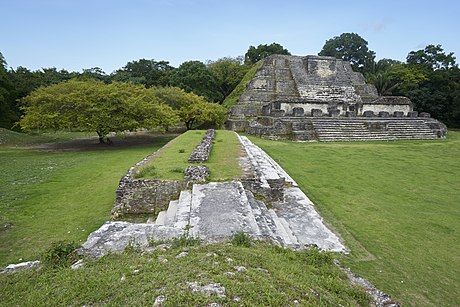Not far from where I spent most of my life, in Cancun, Mexico, lies the beautiful country of Belize. Known for its stunning beaches and turquoise waters, Belize is more than just a Caribbean paradise—it’s also a gateway to the ancient Maya world. In this article, I want to take you with me as we explore one of its most fascinating ancient cities, Altun Ha. Surrounded by lush jungle, this archaeological treasure offers a glimpse into the past, where grand pyramid temples once stood as powerful symbols of Maya culture.
Discovering Altun Ha
Altun Ha, which means “Rockstone Pond” in Maya, is one of Belize’s most important archaeological sites. First inhabited around 200 BCE, it became a thriving religious and commercial hub during the Classic Period of Maya civilization (250-900 CE). Known for its stunning pyramids, Altun Ha was a vital trade center, connecting the ancient Maya trade network with goods like jade, obsidian, and shells flowing through its markets.
The city’s historical importance is still evident in its remarkable structures, particularly the pyramid temples that rise above the landscape. Altun Ha is not only a place of immense historical value but also an iconic site for pyramid enthusiasts—a testament to the architectural skill and cultural depth of the ancient Maya.
The Pyramids of Altun Ha
At the heart of Altun Ha are its awe-inspiring pyramids, the most prominent of which are the Temple of the Masonry Altars and Temple B4. These structures served as religious centers where ceremonies were held and as symbols of the power wielded by the city’s elite.
1. Temple of the Masonry Altars
Standing at 16 meters (about 52 feet) tall, the Temple of the Masonry Altars is the largest and most significant structure in Altun Ha. This pyramid is where one of the most important discoveries in Maya archaeology was made—the Jade Head. Representing the sun god Kinich Ahau, this artifact is the largest carved jade object ever found in the Maya world, weighing nearly 10 pounds. The Jade Head symbolizes the wealth and influence of Altun Ha during its peak.
The temple was likely used for ceremonial purposes, with altars at the top where rituals were performed to honor the gods. Standing before this grand pyramid, I couldn’t help but imagine the ceremonies that once took place here—priests ascending the steps, the scent of incense filling the air, and the people gathered below, watching as offerings were made to the sun god.
2. Temple B4
Though not as tall as the Temple of the Masonry Altars, Temple B4 also holds considerable historical value. It is believed that this temple played a key role in rituals involving the ruling elite and their connection to the divine. Like many Maya temples, it was built to reflect the power of the rulers, serving as a physical symbol of their authority and their role as intermediaries between the gods and the people.

Overlook of the Site from Temple of the Masonry Altars. Wikimedia Commons.
Life and Legacy of Altun Ha
Altun Ha was more than just a ceremonial city—it was a vibrant community supported by trade, agriculture, and religion. The city’s elite resided in more elaborate structures near the central acropolis, while traders, farmers, and other residents lived in smaller dwellings around the city. The plazas were bustling centers of life where the community gathered for rituals, markets, and festivals.
The wealth of Altun Ha is evident in the artifacts uncovered at the site—beautiful jade pieces, obsidian blades, and intricately crafted pottery. The city’s location along important trade routes brought prosperity, allowing it to flourish and build connections with other significant Maya cities like Tikal in present-day Guatemala.
The Decline of Altun Ha
Like many Maya cities, Altun Ha experienced a decline around 900 CE, during the period known as the Maya collapse. The reasons for this widespread decline are still debated, with theories ranging from environmental changes and political instability to resource depletion. By the time the Spanish arrived in the 16th century, Altun Ha had long been abandoned, but its beautiful pyramids remained—silent witnesses to the city’s former glory, like many other sites in Yucatan.
It’s remarkable how much of Altun Ha still stands today. Despite centuries of weathering and abandonment, the pyramids and temples continue to rise above the jungle, providing a tangible connection to the past. I find it incredible how these ancient structures have survived the test of time, and they never fail to remind me of the Maya’s ingenuity and resilience. But then again, I am a “softy” for pyramids, so I am impressed by every wigle pyramid I see, no matter how old or recent, or how small or massive.
Visiting Altun Ha Today
Today, Altun Ha is one of Belize’s most popular archaeological sites, drawing visitors who want to experience the history of the Maya firsthand. Walking among the ruins, you get a real sense of the city’s past. Climbing the pyramids, especially the Temple of the Masonry Altars, offers not just breathtaking views of the surrounding jungle but also a journey back in time to when the Maya thrived here.
For me, Altun Ha isn’t just another ancient site—it’s a window into a civilization that was rich, complex, and deeply connected to the natural world. It’s a place where history, culture, and nature come together, and visiting it is both educational and awe-inspiring. The pyramids of Altun Ha are more than remnants of a bygone era; they are a reminder of a world that once was, of a people who lived in harmony with their environment, and of the timeless stories etched into the stones.
Stepping Back in Time at Altun Ha
Altun Ha is a place where the past comes alive. Like many other ancient cities in Yucatan, and throughout Mexico. Its pyramids, structures, and artifacts tell the story of a once-thriving Maya city that played an important role in trade, religion, and daily life.
Visiting Altun Ha means walking in the footsteps of history, experiencing firsthand the remarkable achievements of the Maya, and appreciating the resilience of these ancient structures that continue to stand tall today. So, if you are looking for an adventure not too far from the beautiful beaches of Belize, Altun Ha should be on your bucket list the next time you decide to take a trip to Belize.

